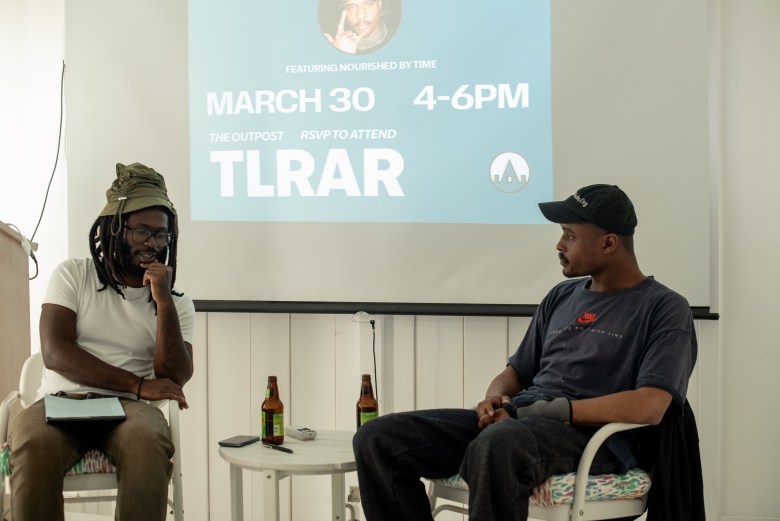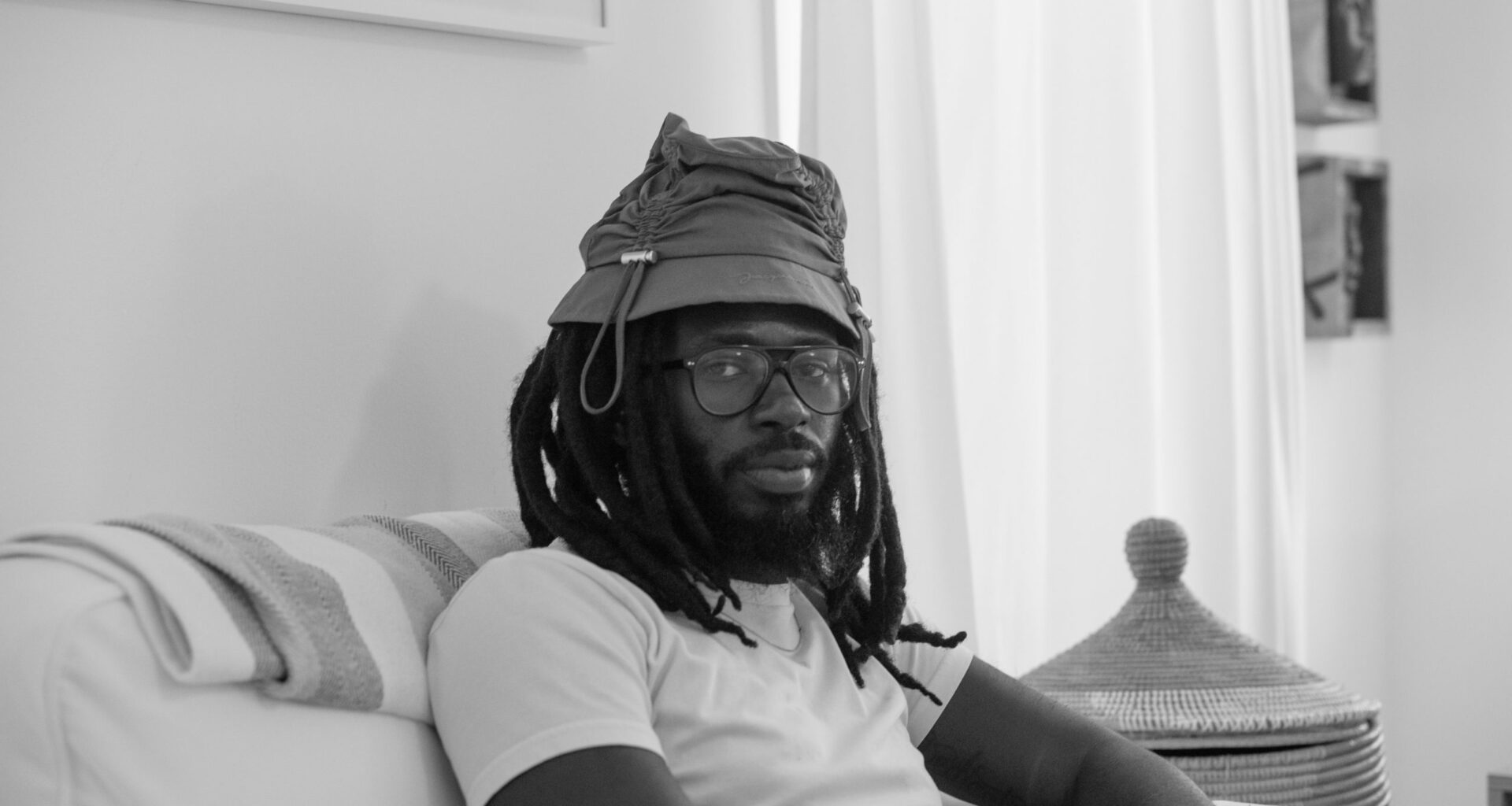Imagine the book as a detailed transcript of the best road trip conversation you’ve had in ages, accompanied by a robust playlist. Each new story transports you to the scene as the soundtrack of Burney’s life plays on. By the final chapters, “Time Is Very Precious” and “MIKE’s World,” Burney delivers a critical perspective on music, culture, and the political commitments needed to survive the rising tide of a conservative milieu and rampant misinformation.
Imagine the book as a detailed transcript of the best road trip conversation you’ve had in ages, accompanied by a robust playlist. Each new story transports you to the scene as the soundtrack of Burney’s life plays on.
Our late summer conversation occurred via Zoom, with me home in West Baltimore while he drove around East Baltimore. Burney is as candid and enlightening on our call as he is in the book, cementing that the work is a well-written extension of the thoughtful, incisive writer who penned it.
Burney is a generous interview partner, and talking with him feels familiar and poignant in the way that chopping it up with another hometown critic should. “No Sense in Wishing” is Burney’s debut monograph, but the Baltimore native has been publishing for over a decade. As founder and editor of True Laurels, a publication that began online in 2011 before becoming a print magazine, Burney committed early to creating the literary space he wanted to share with others.
The memoir, in part, is a story of how a young writer from one of America’s most disregarded cities builds a career as a culture critic. When asked about the early starts of his career, Burney was candid about how his early pieces weren’t as technical as they were evidence of his talent and tenacity. “When I first started consistently blogging, it was probably the beginning of 2012. I actually started getting opportunities to write for national publications before I had to learn how to actually pitch.” He was a young 20-something in the middle of the blog era, hungry to share his insight about music he loved.
The memoir, in part, is a story of how a young writer from one of America’s most disregarded cities builds a career as a culture critic.
The story he shared about his 2013 interview with rap legend Project Pat mirrors vignettes shared throughout the memoir. In conversation and print, Burney puts his audience in the middle of a scene and is a thoughtful guide, sharing what these moments showed him along the way. “Anyone who knows me knows that Project Pat is my favorite rapper. A friend of mine on Twitter who lived in New York made the link between us [Burney and Shabazz]. I went to interview Pat in New York. Shabazz gave me the green light, so I caught the BoltBus up and I met them at a taco spot in Williamsburg.”
Burney’s trip to Williamsburg introduced him to another interviewer, who was wrapping up his time with Project Pat. “He ended up giving me his card, and he was an editor at XXL.” From there, Burney’s career grew.
As he began accruing bylines from XXL and VICE, Burney developed his craft and writing process at home with City Paper in collaboration with trusted editors. “City Paper is the beginning of me looking at writing as a true craft because it was the first time I was actually being edited.” For Burney, the entrance of editors as partners in his publishing marked the shift from side gig to artistic craft.
“When you’re edited, as you know, you could take it personally or you could take it as a challenge to sharpen your skills. And that’s what I did. I was regularly contributing to the City Paper, and I was looking forward to going through that process over and over. [In] 2013, at the time I was like 22, was the beginning of me learning the pitching process. It was the beginning of me thinking of writing as a craft versus a hustle.”
Burney’s early memories show the journey of a writer unwilling to stand as a gatekeeper or a uniquely gifted savant. His responses, like the essays published in his book, show a keen observer unfurling his curiosities in hopes of thinking alongside others, toward an understanding of a larger why.
Relationships, like those built with his collaborators and editors, are the central fulcrum around which “No Sense in Wishing” moves. From the first moments in “A Very Precious Time,” where we meet Burney as a young child witnessing his mother, Victoria Kennedy, and grandfather performing on a Gil Scott-Heron show bill, to his recollections of formative friendships, the memoir is striking. With each page, Burney credits strong, intimate relationships as the key to his artistic craft and his motivation beyond the profession.
When asked about the intimacy of opening up his friendships, like his friendship with musician and poet Abdu Ali, and family relationships, to a public audience, he is matter-of-fact: “The vast majority of the moments in the book are major touchpoints in my journey, so a lot of this stuff I feel like I’ve talked about. Maybe not publicly, but I’ve talked about it to my friends, or me and Abdu have talked about it. I’m pretty open about it.” The difficult task, he told me, was drafting his vast memories into essays with story arcs that others could follow.
As our conversation continued, I asked Burney about the chapter of the book that hasn’t left my mind since I read it: “Bruiser.” “That was the hardest thing I ever had to write in my life. It took me two months to even come up with a first draft. It required a level of vulnerability that I wasn’t comfortable with. It was a thing where when you sit with those kinds of emotions, it just grows inside of you and manifests in ways that I wasn’t interested in harboring anymore. I thought if I put these thoughts and feelings onto a page, then maybe I can put it behind me.” The chapter explores fatherhood, masculinity, violence, and Burney’s journey of caregiving for his daughter while building a career as a writer. Ultimately, the essay is a forthright reflection on Burney’s childhood, impacted by his parents’ divorce, and his parenting decisions now as an adult. It’s one of the most stirring essays on the lure of patriarchal violence and the commitments we must make to give children our best that I’ve ever read.
Burney’s debut is a well-written, rigorous collection opening up the writer’s life in all the right places, so that by “Salutations”, we’re thinking deeper about music and each other. The trip through his memories urges readers to decipher culture beyond its money-making utility as a corporate product for apolitical consumption. He wants us to have questions and seek answers, even if it means questioning art and artists. Throughout the memoir, Burney’s essays tempt us all inward to a place of introspection and analysis. “I don’t think my criticism is about just tearing things down. I’m all about trying to contextualize things within a scene or world or city or region.”
He continues, filling in more detail on his approach to cultural criticism: “So even in my criticism, I am trying to provide some sort of educational element. I’m not trying to teach, but trying to break down what I see and how I see it. And if you provide your readers with an ample amount of context, then readers, who might not agree with you, can understand why I came to that conclusion.”
‘No Sense In Wishing’ is the work of a critic yearning to help us understand why art and culture are elements of larger histories and how those histories impact human relationships.
“No Sense In Wishing” is the work of a critic yearning to help us understand why art and culture are elements of larger histories and how those histories impact human relationships. The collection is a well-done entry into the canon of contemporary memoirs, offering a historiography of Baltimore and music journalism in the early 2010s. In a modern moment obsessed with condensing the best of us into micro clips and bulleted lists, Burney sits us down and helps us settle in for a long, rewarding ride.
 Lawrence Burney (Left) and artist Nurished By Time (Right) sit down and discuss creative inspirations, career track, and Baltimore roots. Photo credit: Sydney J. Allen.
Lawrence Burney (Left) and artist Nurished By Time (Right) sit down and discuss creative inspirations, career track, and Baltimore roots. Photo credit: Sydney J. Allen.
Related

